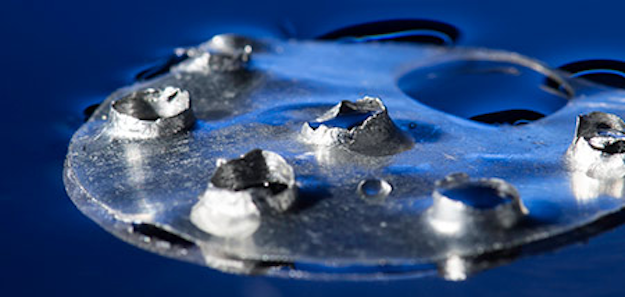
Researchers’ laser process makes metal structure unsinkable
By DE Staff
General Metal FabricationLaser-inscribed nanoscale pattern creates superhydrophobic surface on metal structure, even when damaged.

This laser-etched super hydrophobic metal structure, developed at the University of Rochester, remains afloat even after being repeatedly punctured. (Photo credit: University of Rochester photo / J. Adam Fenster)
The structure relies on a technique that employs femtosecond laser bursts on a metal surface to inscribe nanoscale patterns that trap air, making the metal highly water repellent. While the technique worked in the lab, the researchers found it eventually wore off as the metal surface was immersed in water.
To overcome this, the research team created a metal structure composed of two parallel laser-etched disks attached to each other such that the treated surfaces face each other with a slender gap between them. Inspired by how aquatic spiders and fire ants can survive under water by trapping air against their hydrophobic bodies, the researchers realized that a partially enclosed hydrophobic space would protect against the effect wearing off.
Tests performed at the University of Rochester headed by optics and physics professor, Chunlei Guo, found that the disk structure immediately floated, even after being held under water for two months and being punctured multiple times.
Though the team used aluminum for this project, the “etching process “could be used for literally any metals, or other materials,” Guo says. In addition, he says his lab has increased the speed of its laser etching process from one hour for an one square-inch area to seven times faster, improving the feasibility of commercial applications.
Dr. Chunlei Guo study on the super hydrophobic structure appeared in ACS Applied Materials and Interfaces.
